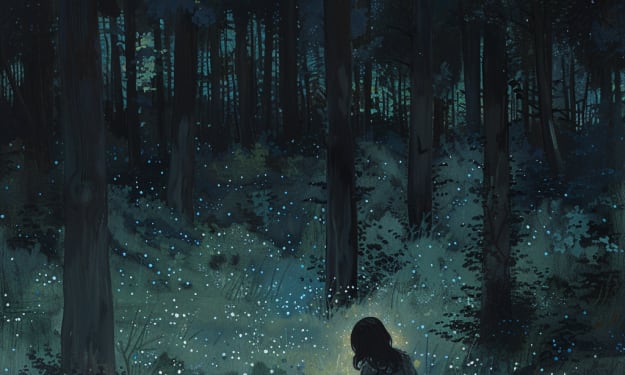A Step Away 2
The Closeness of the Dead and the Cemetery
In the heart of a somber and weathered town, a cemetery lay nestled amidst gnarled trees and overgrown grass. Its entrance was marked by an iron arch, a portal that separated the living from the departed. The townspeople spoke in hushed tones about the cemetery's aura, one that seemed to carry a palpable weight of sorrow and longing. Little did they know that the dead and the cemetery were intricately woven into the fabric of their lives, much closer than they could ever fathom.
The town's history was etched into the tombstones, each one a silent witness to the trials and tribulations of generations past. It was a place where the living dared not tread after dark, for the heavy silence seemed to deepen, and the shadows whispered secrets only the dead could comprehend. But it was precisely this sense of unease that drew James, a curious and introspective young man, to the cemetery's gate one chilly evening.
James had always been captivated by the mysteries of life and death, the enigmatic veil that separated one from the other. His nights were spent poring over ancient texts and philosophical tomes, seeking answers to questions that had eluded humanity for centuries. His fascination wasn't driven by morbid curiosity, but rather by a relentless pursuit of understanding the nature of existence itself.
As he stepped through the iron arch and into the cemetery's heart, the air seemed to grow heavy with memories. The moon's pale glow illuminated the moss-covered tombstones, casting eerie shadows that danced like specters on the ground. A soft breeze rustled through the leaves, carrying with it the distant echo of whispered conversations from the past. James couldn't help but feel a shiver run down his spine, a sensation that mingled excitement and trepidation.
He began to wander among the graves, reading the names and dates etched into the stones. He marveled at the stories hinted at in the brief inscriptions: lives that had once teemed with vitality, now reduced to a few lines of text and weathered stone. It was a poignant reminder of the transience of human existence, a reality that both intrigued and unsettled James.
As he walked deeper into the cemetery, James felt an inexplicable tug on his heartstrings. It was as if the spirits of the departed were reaching out to him, their stories beckoning him to listen. He approached a particularly old and worn gravestone, the name barely legible. With a mixture of reverence and curiosity, he traced his fingers over the letters, as if trying to connect with the essence of the person who lay beneath.
"Thomas Beaumont," James whispered, his voice carried away by the wind. "Who were you? What dreams did you chase, and what sorrows did you carry?"
In the silence that followed, James felt a peculiar sensation—a feeling of being observed, of not being alone. He turned, his heart pounding, to find himself face to face with an apparition. A figure stood before him, dressed in antiquated attire, its features ethereal and translucent. The specter's eyes held a mixture of sadness and longing, a silent invitation to understand the truth that bound the living and the dead.
"You seek answers, young seeker," the specter's voice echoed, its tone a melancholic melody that resonated within James's soul. "The veil between our worlds is thinner than you imagine. The dead and the cemetery are not separated from the living, but intimately intertwined, a mere step away."
James's initial fear gave way to a sense of wonder as he listened to the specter's words. It shared stories of lives lived and lost, of dreams unfulfilled and loves unspoken. The cemetery, the specter explained, was not a place of finality, but a realm of transition—a bridge that connected the echoes of the past to the possibilities of the present.
"You stand on the precipice, young seeker," the specter said, its gaze penetrating the depths of James's thoughts. "Embrace the closeness of the dead and the cemetery, for within their stories lies the essence of what it means to be human."
As the night wore on, James continued to converse with the specter, the two of them traversing the cemetery like old friends sharing long-held secrets. The specter's tales were a tapestry woven from strands of joy and sorrow, of moments both mundane and profound. James realized that these stories were not confined to the past—they were living, breathing threads that connected the departed to the living, transcending the boundaries of time and space.
With the first light of dawn, the specter began to fade, its form dissolving into the soft morning mist. James was left standing amidst the tombstones, a sense of bittersweet longing filling his heart. He understood now that the sorrowful aura that hung over the cemetery was not a burden but a gift, a reminder that life's beauty and fragility were intricately intertwined.
As the days turned into weeks, James found himself returning to the cemetery again and again. He felt a kinship with the departed souls, a connection forged through shared stories and whispered confidences. He came to view the cemetery not as a place of death, but as a sanctuary of memories—a sacred space where the living and the dead could converse, albeit in ways that transcended words.
Word of James's encounters spread throughout the town, sparking both intrigue and skepticism. The notion that the dead were closer than they seemed challenged conventional beliefs, stirring unease among those who preferred the comfortable certainty of the material world. Yet, there were those who, like James, felt an inexplicable pull towards the cemetery, drawn by the promise of connection beyond the veil.
In the midst of the tension between belief and disbelief, tragedy struck the town. A devastating storm swept through, leaving destruction and heartache in its wake. Homes were ravaged, lives were upturned, and the townspeople were forced to confront the fragility of their existence. In the aftermath of the chaos, the cemetery stood as a testament to the town's resilience, a reminder that even in the face of destruction, stories endured.
Amidst the rubble and the tears, James found himself once again in the cemetery's embrace. The tombstones, weathered but unbroken, whispered tales of survival and rebirth. As he traced his fingers over the names, he felt a surge of connection—an affirmation that the dead and the cemetery were not a distant realm, but an integral part of the human experience.
James's encounter with the specter had changed him, transforming his perception of life and death. He had come to understand that the sorrow that clung to the cemetery was not a burden to be avoided, but a reminder of the shared humanity that bound the living and the dead. In the midst of sorrow, there was also beauty—a beauty that could only be appreciated through the lens of connection and empathy.
The town began to heal, and with time, the tension between the living and the dead dissipated. People started visiting the cemetery not just out of obligation, but out of a genuine desire to engage with the stories and memories that resided there. The cemetery ceased to be a place of fear and became a place of communion, a realm where the living and the departed could coexist in a delicate dance of shared experiences.
And so, the town's legacy evolved. The cemetery, once shrouded in mystery and sorrow, became a place of solace and






Comments
There are no comments for this story
Be the first to respond and start the conversation.